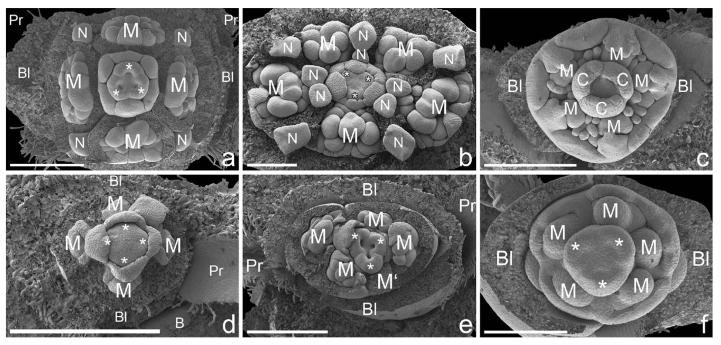Fig. 5.
Bauplan shifts in pseudanthia of (a, b) Neoguillauminiinae, (c, f ) Euphorbiinae and (d, e) Anthosteminae. All figures in natural orientation with the adaxial side (main axis) uppermost (scanning electron micrographs). (a) Calycopeplus paucifolius: pseudanthium preceded by two lateral bracteoles and two lateral prophylls (removed). Female flower with one carpel in adaxial/median position and two in lateral/abaxial position (asterisks; for details see also Figs 1 and 2). (b) Neoguillauminia cleopatra (Baill.) Croizat: pseudanthium preceded by two lateral bracteoles (not shown), female flower with two carpels in adaxial position and one in abaxial/median position (asterisks). (c) Euphorbia ammak Schweinf.: pseudanthium preceded by two lateral bracteoles; orientation of female flower as in (b). (d) Dichostemma glaucescens Pierre: pseudanthium preceded by two bracteoles in median position and one unpaired prophyll in lateral position. Tetramerous female flower, with two carpels in median and two in lateral position (asterisks). (e) Anthostema madagascariense Baill.: pseudanthium preceded by two bracteoles in median position and two prophylls in lateral position. Female flower with two carpels in adaxial and one in abaxial position (asterisks). ( f ) Monadenium torrei L.C.Leach: pseudanthium preceded by two lateral bracteoles. Orientation of female flower as in (b, c and e). Bl, bracteole; C, carpel; M, male partial inflorescence; M′, position of fifth male partial inflorescence; N, nectaries (not shown in all figures); Pr, prophyll. Scale bars = 500 μm (a–e), 300 μm (f).

